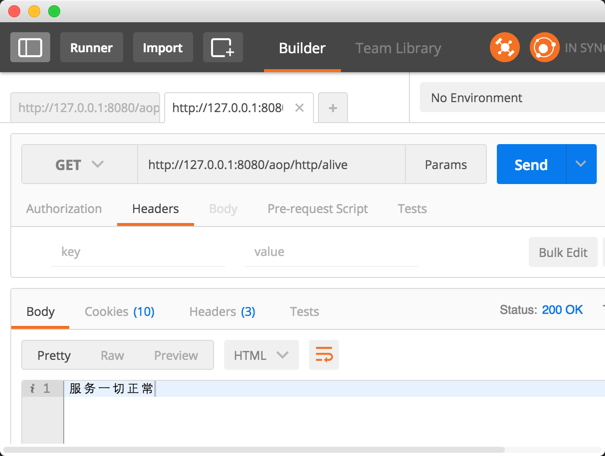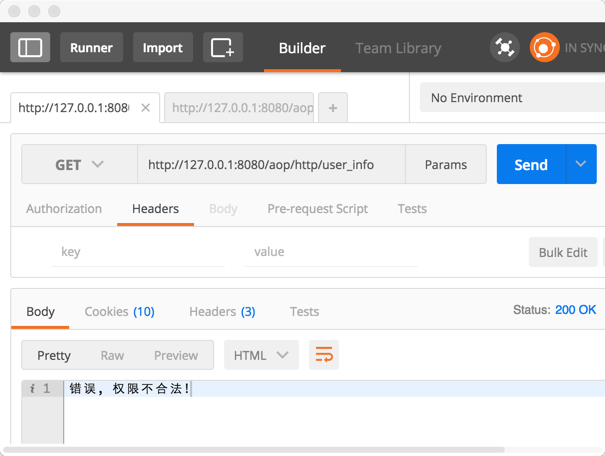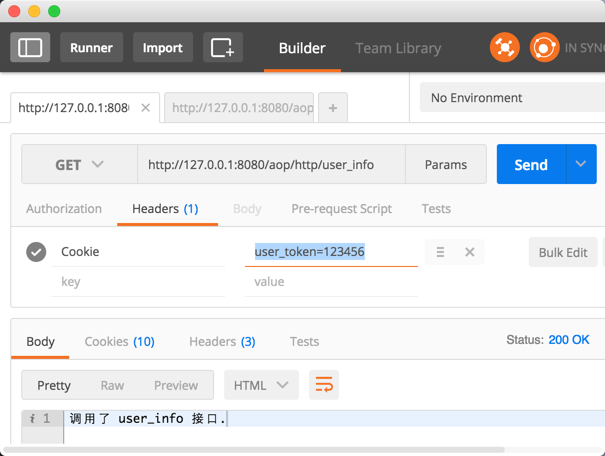本文共 11208 字,大约阅读时间需要 37 分钟。
看了上面这么多的理论知识, 不知道大家有没有觉得枯燥哈. 不过不要急, 俗话说理论是实践的基础, 对 Spring AOP 有了基本的理论认识后, 我们来看一下下面几个具体的例子吧.
下面的几个例子是我在工作中所遇见的比较常用的 Spring AOP 的使用场景, 我精简了很多有干扰我们学习的注意力的细枝末节, 以力求整个例子的简洁性.下面几个 Demo 的源码都可以在我的 上下载到.
HTTP 接口鉴权
首先让我们来想象一下如下场景: 我们需要提供的 HTTP RESTful 服务, 这个服务会提供一些比较敏感的信息, 因此对于某些接口的调用会进行调用方权限的校验, 而某些不太敏感的接口则不设置权限, 或所需要的权限比较低(例如某些监控接口, 服务状态接口等).
实现这样的需求的方法有很多, 例如我们可以在每个 HTTP 接口方法中对服务请求的调用方进行权限的检查, 当调用方权限不符时, 方法返回错误. 当然这样做并无不可, 不过如果我们的 api 接口很多, 每个接口都进行这样的判断, 无疑有很多冗余的代码, 并且很有可能有某个粗心的家伙忘记了对调用者的权限进行验证, 这样就会造成潜在的 bug. 那么除了上面的所说的方法外, 还有没有别的比较优雅的方式来实现呢? 当然有啦, 不然我在这啰嗦半天干嘛呢, 它就是我们今天的主角:AOP. 让我们来提炼一下我们的需求:
-
可以定制地为某些指定的 HTTP RESTful api 提供权限验证功能.
-
当调用方的权限不符时, 返回错误.
根据上面所提出的需求, 我们可以进行如下设计:
-
提供一个特殊的注解
AuthChecker, 这个是一个方法注解, 有此注解所标注的 Controller 需要进行调用方权限的认证. -
利用 Spring AOP, 以 @annotation 切点标志符来匹配有注解
AuthChecker所标注的 joinpoint. -
在 advice 中, 简单地检查调用者请求中的 Cookie 中是否有我们指定的 token, 如果有, 则认为此调用者权限合法, 允许调用, 反之权限不合法, 范围错误.
根据上面的设计, 我们来看一下具体的源码吧.
首先是AuthChecker 注解的定义:AuthChecker.java: @Target(ElementType.METHOD)@Retention(RetentionPolicy.RUNTIME)public @interface AuthChecker {} AuthChecker 注解是一个方法注解, 它用于注解 RequestMapping 方法.
有了注解的定义, 那我们再来看一下 aspect 的实现吧:
HttpAopAdviseDefine.java:@Component@Aspectpublic class HttpAopAdviseDefine { // 定义一个 Pointcut, 使用 切点表达式函数 来描述对哪些 Join point 使用 advise. @Pointcut("@annotation(com.xys.demo1.AuthChecker)") public void pointcut() { } // 定义 advise @Around("pointcut()") public Object checkAuth(ProceedingJoinPoint joinPoint) throws Throwable { HttpServletRequest request = ((ServletRequestAttributes) RequestContextHolder.getRequestAttributes()) .getRequest(); // 检查用户所传递的 token 是否合法 String token = getUserToken(request); if (!token.equalsIgnoreCase("123456")) { return "错误, 权限不合法!"; } return joinPoint.proceed(); } private String getUserToken(HttpServletRequest request) { Cookie[] cookies = request.getCookies(); if (cookies == null) { return ""; } for (Cookie cookie : cookies) { if (cookie.getName().equalsIgnoreCase("user_token")) { return cookie.getValue(); } } return ""; }} 在这个 aspect 中, 我们首先定义了一个 pointcut, 以 @annotation 切点标志符来匹配有注解 AuthChecker 所标注的 joinpoint, 即:
// 定义一个 Pointcut, 使用 切点表达式函数 来描述对哪些 Join point 使用 advise.@Pointcut("@annotation(com.xys.demo1.AuthChecker)")public void pointcut() {} 然后再定义一个 advice:
// 定义 advise@Around("pointcut()")public Object checkAuth(ProceedingJoinPoint joinPoint) throws Throwable { HttpServletRequest request = ((ServletRequestAttributes) RequestContextHolder.getRequestAttributes()) .getRequest(); // 检查用户所传递的 token 是否合法 String token = getUserToken(request); if (!token.equalsIgnoreCase("123456")) { return "错误, 权限不合法!"; } return joinPoint.proceed();} 当被 AuthChecker 注解所标注的方法调用前, 会执行我们的这个 advice, 而这个 advice 的处理逻辑很简单, 即从 HTTP 请求中获取名为 user_token 的 cookie 的值, 如果它的值是 123456, 则我们认为此 HTTP 请求合法, 进而调用 joinPoint.proceed() 将 HTTP 请求转交给相应的控制器处理; 而如果user_token cookie 的值不是 123456, 或为空, 则认为此 HTTP 请求非法, 返回错误.
接下来我们来写一个模拟的 HTTP 接口:
DemoController.java:@RestControllerpublic class DemoController { @RequestMapping("/aop/http/alive") public String alive() { return "服务一切正常"; } @AuthChecker @RequestMapping("/aop/http/user_info") public String callSomeInterface() { return "调用了 user_info 接口."; }} 注意到上面我们提供了两个 HTTP 接口, 其中 接口 /aop/http/alive 是没有 AuthChecker 标注的, 而 /aop/http/user_info接口则用到了 @AuthChecker 标注. 那么自然地, 当请求了 /aop/http/user_info 接口时, 就会触发我们所设置的权限校验逻辑.
接下来我们来验证一下, 我们所实现的功能是否有效吧.
首先在 Postman 中, 调用 /aop/http/alive 接口, 请求头中不加任何参数:可以看到, 我们的 HTTP 请求完全没问题.
那么再来看一下请求 /aop/http/user_info 接口会怎样呢:
当我们请求 /aop/http/user_info 接口时, 服务返回一个权限异常的错误, 为什么会这样呢? 自然就是我们的权限认证系统起了作为: 当一个方法被调用并且这个方法有 AuthChecker 标注时, 那么首先会执行到我们的 around advice, 在这个 advice 中, 我们会校验 HTTP 请求的 cookie 字段中是否有携带 user_token 字段时, 如果没有, 则返回权限错误.
注意, Postman 默认是不支持 Cookie 的, 所以为了实现添加 Cookie 的功能, 我们需要安装 Postman 的interceptor插件. 安装方法可以看
完整源码
方法调用日志
第二个 AOP 实例是记录一个方法调用的log. 这应该是一个很常见的功能了.
首先假设我们有如下需求:-
某个服务下的方法的调用需要有 log: 记录调用的参数以及返回结果.
-
当方法调用出异常时, 有特殊处理, 例如打印异常 log, 报警等.
根据上面的需求, 我们可以使用 before advice 来在调用方法前打印调用的参数, 使用 after returning advice 在方法返回打印返回的结果. 而当方法调用失败后, 可以使用 after throwing advice 来做相应的处理.
那么我们来看一下 aspect 的实现:@Component@Aspectpublic class LogAopAdviseDefine { private Logger logger = LoggerFactory.getLogger(getClass()); // 定义一个 Pointcut, 使用 切点表达式函数 来描述对哪些 Join point 使用 advise. @Pointcut("within(NeedLogService)") public void pointcut() { } // 定义 advise @Before("pointcut()") public void logMethodInvokeParam(JoinPoint joinPoint) { logger.info("---Before method {} invoke, param: {}---", joinPoint.getSignature().toShortString(), joinPoint.getArgs()); } @AfterReturning(pointcut = "pointcut()", returning = "retVal") public void logMethodInvokeResult(JoinPoint joinPoint, Object retVal) { logger.info("---After method {} invoke, result: {}---", joinPoint.getSignature().toShortString(), joinPoint.getArgs()); } @AfterThrowing(pointcut = "pointcut()", throwing = "exception") public void logMethodInvokeException(JoinPoint joinPoint, Exception exception) { logger.info("---method {} invoke exception: {}---", joinPoint.getSignature().toShortString(), exception.getMessage()); }} 第一步, 自然是定义一个 pointcut, 以 within 切点标志符来匹配类 NeedLogService 下的所有 joinpoint, 即:
@Pointcut("within(NeedLogService)")public void pointcut() {} 接下来根据我们前面的设计, 我们分别定义了三个 advice, 第一个是一个 before advice:
@Before("pointcut()")public void logMethodInvokeParam(JoinPoint joinPoint) { logger.info("---Before method {} invoke, param: {}---", joinPoint.getSignature().toShortString(), joinPoint.getArgs());} 它在一个符合要求的 joinpoint 方法调用前执行, 打印调用的方法名和调用的参数.
第二个是 after return advice:
@AfterReturning(pointcut = "pointcut()", returning = "retVal")public void logMethodInvokeResult(JoinPoint joinPoint, Object retVal) { logger.info("---After method {} invoke, result: {}---", joinPoint.getSignature().toShortString(), joinPoint.getArgs());} 这个 advice 会在方法调用成功后打印出方法名还反的参数.
最后一个是 after throw advice:
@AfterThrowing(pointcut = "pointcut()", throwing = "exception")public void logMethodInvokeException(JoinPoint joinPoint, Exception exception) { logger.info("---method {} invoke exception: {}---", joinPoint.getSignature().toShortString(), exception.getMessage());} 这个 advice 会在指定的 joinpoint 抛出异常时执行, 打印异常的信息.
接下来我们再写两个 Service 类:
NeedLogService.java:@Servicepublic class NeedLogService { private Logger logger = LoggerFactory.getLogger(getClass()); private Random random = new Random(System.currentTimeMillis()); public int logMethod(String someParam) { logger.info("---NeedLogService: logMethod invoked, param: {}---", someParam); return random.nextInt(); } public void exceptionMethod() throws Exception { logger.info("---NeedLogService: exceptionMethod invoked---"); throw new Exception("Something bad happened!"); }} NormalService.java:
@Servicepublic class NormalService { private Logger logger = LoggerFactory.getLogger(getClass()); public void someMethod() { logger.info("---NormalService: someMethod invoked---"); }} 根据我们 pointcut 的规则, 类 NeedLogService 下的所有方法都会被织入 advice, 而类 NormalService 则不会.
最后我们分别调用这几个方法:
@PostConstructpublic void test() { needLogService.logMethod("xys"); try { needLogService.exceptionMethod(); } catch (Exception e) { // Ignore } normalService.someMethod();} 我们可以看到有如下输出:
---Before method NeedLogService.logMethod(..) invoke, param: [xys]------NeedLogService: logMethod invoked, param: xys------After method NeedLogService.logMethod(..) invoke, result: [xys]------Before method NeedLogService.exceptionMethod() invoke, param: []------NeedLogService: exceptionMethod invoked------method NeedLogService.exceptionMethod() invoke exception: Something bad happened!------NormalService: someMethod invoked---
根据 log, 我们知道, NeedLogService.logMethod 执行的前后确实有 advice 执行了, 并且在 NeedLogService.exceptionMethod 抛出异常后, logMethodInvokeException 这个 advice 也被执行了. 而由于 pointcut 的匹配规则, 在 NormalService 类中的方法则不会织入 advice.
完整源码
方法耗时统计
作为程序员, 我们都知道服务监控对于一个服务能够长期稳定运行的重要性, 因此很多公司都有自己内部的监控报警系统, 或者是使用一些开源的系统, 例如小米的 Falcon 监控系统.
那么在程序监控中, AOP 有哪些用武之地呢? 我们来假想一下如下场景:
有一天, leader 对小王说, "小王啊, 你负责的那个服务不太稳定啊, 经常有超时发生! 你有对这些服务接口进行过耗时统计吗?"
耗时统计? 小王嘀咕了, 小声的回答到: "还没有加呢." leader: "你看着办吧, 我明天要看到各个时段的服务接口调用的耗时分布!" 小王这就犯难了, 虽然说计算一个方法的调用耗时并不是一个很难的事情, 但是整个服务有二十来个接口呢, 一个一个地添加统计代码, 那还不是要累死人了. 看着同事一个一个都下班回家了, 小王眉头更加紧了. 不过此时小王灵机一动: "噫, 有了!". 小王想到了一个好方法, 立即动手, 吭哧吭哧地几分钟就搞定了.
那么小王的解决方法是什么呢? 自然是我们的主角 AOP 啦.
首先让我们来提炼一下需求:
-
为服务中的每个方法调用进行调用耗时记录.
-
将方法调用的时间戳, 方法名, 调用耗时上报到监控平台
有了需求, 自然设计实现就很简单了. 首先我们可以使用 around advice, 然后在方法调用前, 记录一下开始时间, 然后在方法调用结束后, 记录结束时间, 它们的时间差就是方法的调用耗时.
我们来看一下具体的 aspect 实现:
ExpiredAopAdviseDefine.java:
@Component@Aspectpublic class ExpiredAopAdviseDefine { private Logger logger = LoggerFactory.getLogger(getClass()); // 定义一个 Pointcut, 使用 切点表达式函数 来描述对哪些 Join point 使用 advise. @Pointcut("within(SomeService)") public void pointcut() { } // 定义 advise // 定义 advise @Around("pointcut()") public Object methodInvokeExpiredTime(ProceedingJoinPoint pjp) throws Throwable { StopWatch stopWatch = new StopWatch(); stopWatch.start(); // 开始 Object retVal = pjp.proceed(); stopWatch.stop(); // 结束 // 上报到公司监控平台 reportToMonitorSystem(pjp.getSignature().toShortString(), stopWatch.getTotalTimeMillis()); return retVal; } public void reportToMonitorSystem(String methodName, long expiredTime) { logger.info("---method {} invoked, expired time: {} ms---", methodName, expiredTime); // }} aspect 一开始定义了一个 pointcut, 匹配 SomeService 类下的所有的方法.
@Around("pointcut()")public Object methodInvokeExpiredTime(ProceedingJoinPoint pjp) throws Throwable { StopWatch stopWatch = new StopWatch(); stopWatch.start(); // 开始 Object retVal = pjp.proceed(); stopWatch.stop(); // 结束 // 上报到公司监控平台 reportToMonitorSystem(pjp.getSignature().toShortString(), stopWatch.getTotalTimeMillis()); return retVal;} advice 中的代码也很简单, 它使用了 Spring 提供的 StopWatch 来统计一段代码的执行时间. 首先我们先调用 stopWatch.start() 开始计时, 然后通过 pjp.proceed() 来调用我们实际的服务方法, 当调用结束后, 通过 stopWatch.stop() 来结束计时.
接着我们来写一个简单的服务, 这个服务提供一个 someMethod 方法用于模拟一个耗时的方法调用:
SomeService.java:@Servicepublic class SomeService { private Logger logger = LoggerFactory.getLogger(getClass()); private Random random = new Random(System.currentTimeMillis()); public void someMethod() { logger.info("---SomeService: someMethod invoked---"); try { // 模拟耗时任务 Thread.sleep(random.nextInt(500)); } catch (InterruptedException e) { e.printStackTrace(); } }} 这样当 SomeService 类下的方法调用时, 我们所提供的 advice 就会被执行, 因此就可以自动地为我们统计此方法的调用耗时, 并自动上报到监控系统中了.
AOP 的威力了吧, 我们这里仅仅使用了寥寥数语就把一个需求完美地解决了, 并且还与原来的业务逻辑完全解耦, 扩展及其方便. 完整源码
总结
通过上面的几个简单例子, 我们对 Spring AOP 的使用应该有了一个更为深入的了解了. 其实 Spring AOP 的使用的地方不止这些, 例如 Spring 的 声明式事务 就是在 AOP 之上构建的. 读者朋友也可以根据自己的实际业务场景, 合理使用 Spring AOP, 发挥它的强大功能!
End.
转载地址:http://guie.baihongyu.com/


